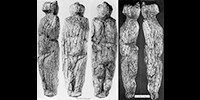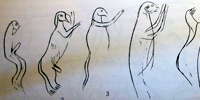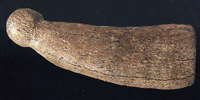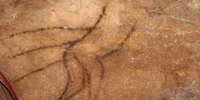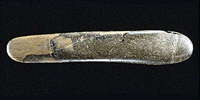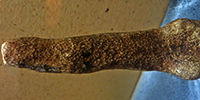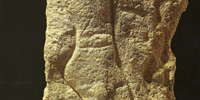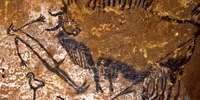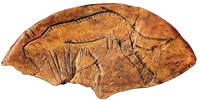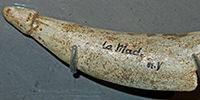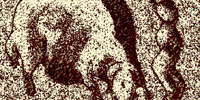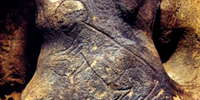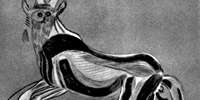| Linked image |
Linked information |
Presently held at |
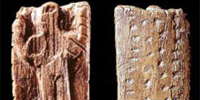 |
The Worshipper, called 'Adorant', is one of the oldest, most impressive and mystifying statuettes from the Ice Age. It was discovered in an ashy bone layer near a possible hearth at Geißenklösterle. The bas-relief of a human being with raised arms, who seems to be either saluting or threatening, can be distinguished. The raised arms might also be interpreted as an attitude of worship, so the statuette was named the 'Adorant'. |
Württemberg Landesmuseum, Stuttgart |
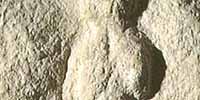 |
Abri Pataud Venus - The Venus of Abri Pataud, as well as the site of Abri Pataud. |
Musée de l'Homme, Paris |
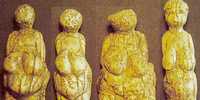 |
Avdeevo - Venus figures and other finds from this important archaeological site. The Avdeevo venus figures are quite variable, but most depict mature women in various stages of the reproductive cycle. Avdeevo is located on the Sejm River near the city of Kursk, Russia. Two oval living areas surrounded by semisubterranean lodges and pits have been identified at Avdeevo. Both were occupied between 21 000 and 20 000 BP. The tool inventory consists of Kostenki knives, shouldered points, and leaf points on blades. |
Collection of the Museum of Anthropology of the University of Moscow |
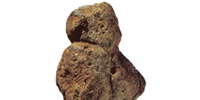 |
The female figurine from Berekhat Ram, in Israel is one of the oldest known figurative carvings in the world, and is somewhere between 250 000 and 280 000 years old, older than Neanderthal man, and probably carved by Homo Erectus. The original pebble bore a resemblance to a female, and this was enhanced by the carver, who cut grooves around the neck and along its arms. Microscopic analysis by Alexander Marshack has now made it clear that humans were responsible. |
Hebrew University of Jerusalem (?) |
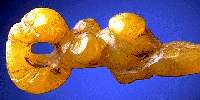 |
Balzi Rossi Venuses - the Grimaldi Venuses. On the Liguria coast are the entrances of the complex of the caverns of the Balzi Rossi (literally red leaps). The complex is composed of numerous coves and shelters. The first searches occurred in 1846-57, by the prince of Monaco, Florestano I. More recently, between 1928 and 1959, regular diggings were executed. Louis Alexandre Jullien discovered, between 1883 and 1895, about fifteen figurines, the greatest series ever found in only one place in Western Europe. |
The best are at the Musée Antiquitées Nationales in France, one is at the Peabody Museum, and several in private hands |
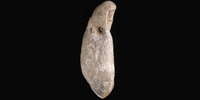 |
The Venus of Bedeilhac - also known as la Femme à la Capuche. It is formed from a horse canine tooth, pierced and sculpted. 47 mm long. Discovered in the Jauze-Mandement section, the third terrace. It was part of a necklace of perforated teeth. The sculpture represents a human head with eyes, a very large nose, and it seems amazed, as the mouth is partially open. The figure is framed by a sort of hood. There is a biconical transverse perforation through the neck. It was discovered by Joseph Mandement, who also made the first crossing of the Green Lake at Niaux. He was an amateur archeologist, and made many discoveries at Niaux, Mas d'Azil and Bédeilhac. |
(?) |
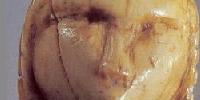 |
Brassempouy Venus - this miniature head, 36.5 mm high, 22 mm deep and 19 mm wide, was carved from mammoth ivory. Found at Brassempouy, Landes, France in 1892. It may be 25 000 years old. It is one of the few Ice Age figures with facial features and a detailed hairstyle. It is the original for the 'Ayla' head from Jean Auel's Earth Children series of books. Some doubt its authenticity, since it was recovered at a dig where the workers were paid by what they discovered. |
MAN47019, La salle Piette, Musée d'Archéologie Nationale et Domaine, St-Germain-en-Laye |
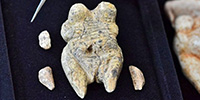 |
Three small ivory fragments from Breitenbach, which are only between 14 mm and 18 mm in size seem to be very inconspicuous at first glance, but have been carefully worked and polished on the surface, and can be fitted effortlessly into completely preserved figures such as those known from the 'Hohle Fels' in the Swabian Alb. Breitenbach represents one of the northernmost sites of the Aurignacian. |
Monrepos Archäologisches Forschungszentrum und Museum für menschliche Verhaltensevolution (?) |
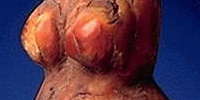 |
The Brown Ivory Figurine, Armless Lady, Figurine en ivoire brun, or Abrachiale, one of the Balzi Rossi Venus figures, is a nearly complete female figurine made from partially fossilised ivory found at Balzi Rossi. The nearly circular head lacks any indication of facial features or hair and no arms or hands are present. The roughly hemispherical breasts are large and separated from each other by a deep groove. Protruding even more than the breasts is the oval-shaped enlarged abdomen. |
Private hands. The Bust, Nun, Armless Lady, Ochre Lady, Two-Headed Lady, Couple, and the Mask were displayed in an exhibition at the Canadian Museum of History, Gatineau, Canada, in 1995. |
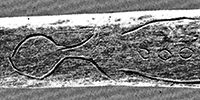 |
This engraving is known as the Bruniquel Venus. |
(?) |
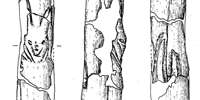 |
This Venus figure from Las Caldas Cave has the head of an ibex and the legs and genitals of a female human. Some think it is not meant to be a venus, but is part of an atlatl, a spear thrower. |
(?) |
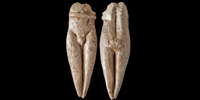 |
The Venus called la figurine à la Ceinture or the figurine with a belt, from the Grottes du Pape, Brassempouy, displays the lower part of a human body. It is difficult to determine the sex. The belly is as flat as that of a man. The hips and thighs have female contours. The legs are pressed one against the other, and end in points. The sexual organs are not shown distinctly, and this suggests that they are not those of a man. This figurine never had feet. The vertical groove in the back is deep. |
MAN47077, La salle Piette, Musée d'Archéologie Nationale et Domaine, St-Germain-en-Laye |
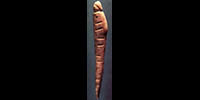 |
Cellier Venus - this Venus figure was carved from mammoth ivory. Only about five centimetres tall, the figure was found at Abri Cellier in France. The head and hairline are clearly visible. The paired marks are common on Aurignacian objects but their significance is not known. |
Logan Museum, Beloit College |
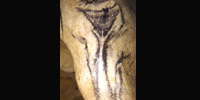 |
The Venus figure of Chauvet Cave is a conical pendant from the roof of the cave, and consists of a bison and an exaggerated depiction of a pubic triangle and a vulva, with rudimentary legs ending in points rather than feet. The rock pendant is seen by some as penis like. The whole ensemble is sometimes known as the sorcerer. Although not visible here, the bison is reported to include a human hand on its lower body. |
Chauvet Cave |
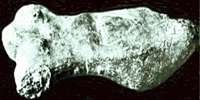 |
Craiova Venus - The Venus of Craiova, Oltenia, Romania.
|
Muzeul Olteniei, Craiova, Romania |
 |
The Venus of Dolni Vestonice is a Venus figurine, a ceramic statuette of a nude female figure dated to 29 000 – 25 000 BP (Gravettian industry). This figurine, together with a few others from nearby locations, is the oldest known ceramic in the world, predating the use of fired clay to make pottery. It has a height of 111 millimetres (4.4 in), and a width of 43 millimetres (1.7 in) at its widest point and is made of a clay body fired at a relatively low temperature. The paleolithic settlement of Dolní Věstonice in Moravia, Czech Republic, has been under systematic archaeological research since 1924, initiated by Karel Absolon. In addition to the Venus figurine, figures of animals – bear, lion, mammoth, horse, fox, rhino and owl – and more than 2 000 balls of burnt clay have been found at Dolní Věstonice. The figurine was discovered on 13 July 1925 in a layer of ash, broken into two pieces.
|
Pavilon Anthropos: Moravské zemské muzeum, in Brno, Czech Republic |
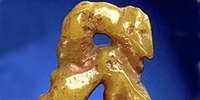 |
In the Double Figurine, or Couple, one of the Balzi Rossi Venus figures, the artist has carved two bodies, back to back, symmetrically arched, and joined at the top of the heads, shoulders and lower body. One represents a woman; the other could be an animal. A hollow space separates the two heads, suggesting that the figurine was used as a pendant. With its back to the woman is the other figure, which has elongated, sinuous anatomical features that are difficult to associate with any known genre. Although the torso and lower body offer limited detail for interpretation, the face brings to mind a beast - real or mythical, we do not know. Carved on a fragment of greenish-yellow serpentine and highly polished, the piece is approximately 47 millimetres high.
|
Private hands. The Bust, Nun, Armless Lady, Ochre Lady, Two-Headed Lady, Couple / Double Figurine, and the Mask were displayed in an exhibition at the Canadian Museum of History, Gatineau, Canada, in 1995. |
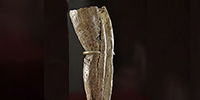 |
This figurine fragment, known as l'Ébauche, (the rough-out), was found at Brassempouy during the AFAS excursion of September 19, 1892.
|
MAN47022, La Salle Piette, Musée d'Archéologie Nationale et Domaine, St-Germain-en-Laye |
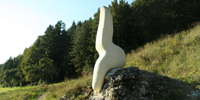 |
The Engen (Petersfels) venuses are made of jet, or hard coal, and were found at the Petersfels site, near Engen in Germany. It is one of the most important Palaeolithic sites in Central Europe with an enormous number of important artefacts. It was a settlement site of the Magdalenian (late Upper Paleolithic), with many layers, towards the end of the last ice age, during the period 15 500-14 000 BP. The main activity here was reindeer hunting in autumn.
|
Archäologisches Museum Colombischlössle, Freiburg, Germany |
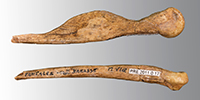 |
Abri Fontales in the l'Aveyron gorge, in Tarn-et-Garonne has venus figures and engravings of the Lalinde type, from circa 15 000 BP - 12 000 BP. |
Muséum de Toulouse |
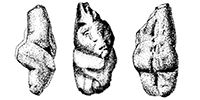 |
This statuette discovered at the foot of the rock escarpment of l'abri d'Enval in 1970 is one of the smallest known palaeolithic figurines, being 31 mm high, with a width of 15 mm and a thickness of 14 mm. It was made of soft sandstone more than 13 000 years ago.
|
(?) |
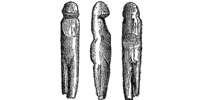 |
The Venus called la fillette or la poupée, from the Grottes du Pape, Brassempouy, is a figurine of a girl, made with just a few blows of the flint. It is a child's toy. She has no arms, and probably never had feet. She is naked, and her hair is long. The sex is shown.
|
MAN47335, La salle Piette, Musée d'Archéologie Nationale et Domaine, St-Germain-en-Laye |
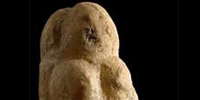 |
The Venus of Frasassi was carved from a piece of stalactite in the Upper Paleolithic, between 28 thousand and 20 thousand years ago. Its color is pearl white.The face is barely shown. Breasts are large, and placed high on the chest. A navel is shown on the full abdomen, and the vulva is clearly shown in relief. Legs taper to about below the level of the knees, which are not shown, when they are broken off or were never carved. Most unusually, the forearms extend well in front of the body, as though they were used to hold something.
|
(?) |
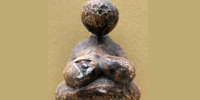 |
The Gagarino venus which is most well known is of an obese woman from the Gagarino site, located on the right bank of the Don River near the Sosna tributary. Here peasants discovered a house pit while excavating a silo trench. Zamiatinine, who excavated this site during 1926 - 1929, found a house pit roughly oval in outline about 5.5 metres long and 4.5 metres wide. The wealth of material remains found in this one house pit is seen in the recorded finds of some six hundred flint implements, over a thousand blades, and proportionately large numbers of cores and waste flints. Artefacts of bone as well as seven 'venus' figurines completed the roster of non-lithic material.
|
(?) |
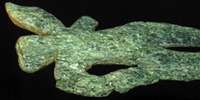 |
Galgenberg Venus - Fanny - Venus vom Galgenberg is the oldest figurine of a woman apart from the Berekhat Ram figure and the Venus of Hohle Fels ever found, and was created around 30 000 BP. Found on September 23, 1988 during the excavation of a habitation of palaeolithic hunters at Galgenberg near Stratzing (Lower Austria), broken into several pieces. 72 mm high figurine of a woman weighing 10 grams and made of greenish, very shiny amphibolite slate, the upper body is turned to the side, in a dancing position, and has a three-dimensional front, flat back, believed to have had cultic or religious significance. |
Vienna Natural History Museum |
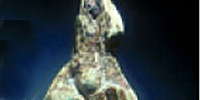 |
The Woman with Goitre / Goiter from Grimaldi has only one torso and one head, but underneath, she has two pubic triangles and two opposite legs. The figure is made of ivory, and is 45 mm long. The face is ovoid, but there are no facial features shown, and no arms. The breasts are conical with the tips pointed down. There is a goitre at the neck. The belly is prominent, the hips are wide, and the buttocks flattened. The vulva is open, with a gynecological perspective. The legs are broken off below the vulva. The 'Woman with Goitre' was found between 3 and 4.2 m deep in a layer which is probably the final Epigravettian. A radiocarbon date of 14 110 ± 150 BP (Gif-sur-Yvette A95074) may be allotted (with caution) to this layer. It may be that this figure is the same age. |
MAN49283, La salle Piette, Musée d'Archéologie Nationale et Domaine, St-Germain-en-Laye |
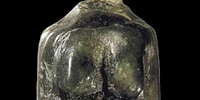 |
The Hermaphrodite Venus from Balzi Rossi is of translucent green soapstone. The surface is polished and worn, with remains of concretions in the concave parts. The neck, what remains of it, is shown clearly. The torso is very flat, with normal breasts hanging low. The belly is large. Under the stomach are three difficult to interpret features: the central feature is held to be an erect penis, but this is unconvincing. It takes a lot of imagination to distinguish the penis, which remains the essential element of the phallic representation. As for the roughly circular mass that is found below it, it could be a testicular pouch. |
MAN49280, Musée d'Archéologie Nationale et Domaine, St-Germain-en-Laye |
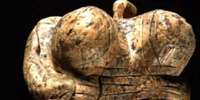 |
Hohle Fels Venus - The Venus of Hohle Fels is an Upper Paleolithic Venus figurine dated to between 35 000 and 40 000 years ago, belonging to the early Aurignacian, and is the oldest undisputed example of Upper Paleolithic art and figurative prehistoric art in general. |
Urgeschichtliches Museum, Blaubeuren, Germany |
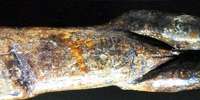 |
Impudique Venus - The Venus Impudique (Immodest Venus). Discovered in 1864 by the Marquis Paul de Vibraye at Laugerie Basse. It was the first Venus figure found in France. The Marquis was playfully reversing the appellation of "Venus pudica" ("modest Venus") that is used to describe a statue type of the Classical Venus which shows, in many statues the goddess attempting to conceal her breasts and pubic area from view. The inference the Marquis makes is that this prehistoric Venus makes no attempt to hide her sexuality. This ivory venus is 8 cm high, and has lost the head. The stomach is flat, and could be of a young girl. |
Musée de l'Homme, Paris |
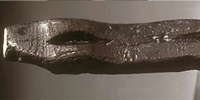 |
The Kesslerloch Venus has been made from a piece of jet. The breasts have been shown by a V shaped notch in the upper part of the figure. In the same fashion, the legs are separated by a V shaped notch. The back of the figure mostly still shows the original surface. Overall, the whole figure is angular and unfinished. Perhaps this is only a work in progress. It was discovered in 1954 by W. Mamber in the old excavation of Jakob Nüesch. Kesslerloch is a Swiss cave discovered in 1873, west of Thayngen, in the canton of Schaffhausen, a Palaeolithic site, with many discoveries of stone, bone and reindeer antler. |
Museum der Kulturen Basel, Switzerland
|
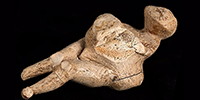 |
A venus figure carved in mammoth ivory, from circa 23 000 BP, has been discovered at the East Gravettian Khotylevo 2 site by Dr Konstantin N. Gavrilov, from the Institute of Archaeology, RAS. The Upper Paleolithic site of Khotylevo 2 is situated 400 km SSW of Moscow and 25 km NW of Bryansk. |
Institute of Archaeology, Russian Academy of Sciences, Moscow (?) |
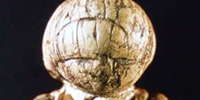 |
Venus figures from the Kostenki - Borshevo region on the Don River. Kostenki is a very important Palaeolithic site. It was a settlement which contained venus figures, dwellings made of mammoth bones, and many flint tools and bone implements. |
Hermitage Museum, Saint Petersburg, Russia |
 |
Krasnyy Yar Venus - The Siberian Paleolithic site of Krasnyy Yar, located on the right bank of the Angara, about 200 km downstream of Irkutsk, which itself is 72 kilometres from the outflow of the Angara River from Lake Baikal, yielded in 1957, a highly stylised female figure. It is a small figurine of bone, carefully polished, whose size is 37mm x 11mm x 8 mm. The area at the time was an arid arctic steppe, and oil shale gathered nearby was used for fuel. |
(?) |
 |
Lalinde / Gönnersdorf figurines and engravings are strictly stylised, overtly female forms with over-sized buttocks, long trunks, small or missing breasts, and no heads. These images have been found at sites such as Gönnersdorf in Germany, in Abri Murat and Gare de Couze in France, Pekárna in the Czech Republic, and Wilczyce in Poland. |
Musée National de Préhistoire, Les Eyzies; Field Museum, Chicago; Monrepos Archäologisches Forschungszentrum und Museum, Neuwied, Germany; Landesamt für Denkmalpflege, Koblenz; Pavilon Anthropos Moravské zemské muzeum, Brno |
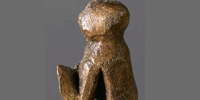 |
The Venus of Laugerie Basse - the Supplicant. This venus is a tiny, broken, crudely carved statuette of reindeer antler, 44 millimetres long, depicting a faceless human bent forward as though in supplication, with arms raised as if in prayer or adoration. |
Musée d'Archéologie Nationale et Domaine, St-Germain-en-Laye (?)
|
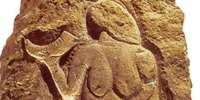 |
Lausell Venus - The Femme à la Corne. This low relief venus is from Laussel, Dordogne. 44 cm (17.5 inches) high. The body swells out towards the viewer from this convex block of limestone. It formed one of a set, a frieze which included other female figures and a male figure. It probably dates to 27 000 - 22 000 BP. It was originally carved on a block of 4 cubic metres (140 cubic feet), and was originally covered in red ochre. The bison's horn and the series of 13 lines on it have often been linked with the moon or menstruation. The lines may represent the thirteen days of the waxing moon and the thirteen months of the lunar year. |
Musée d'Aquitaine à Bordeaux
|
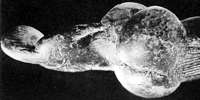 |
Lespugue Venus - The Venus of Lespugue is a statuette of a nude female figure from the Gravettian period, dated to between 26 000 and 24 000 years ago. It was discovered in 1922 in the Rideaux cave of Lespugue (Haute-Garonne). Approximately 6 inches (150 mm) tall, it is carved from tusk ivory, and was damaged during excavation. Of all the steatopygous (large posterior) Venus figurines discovered from the upper Paleolithic, the Venus of Lespugue, if the reconstruction is sound, appears to display the most exaggerated female secondary sexual characteristics, especially the extremely large, pendulous breasts.
|
Musée de l'Homme, Paris
|
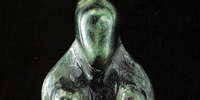 |
The Losange Venus, or Venus el Rombo, is made of green steatite. The head is pointed, with a lack of facial features. There is a groove marking the outline of the hair. The breasts are elongated and large. There are no arms. The protruding belly is circular in shape, and the venus has wide hips, and the buttocks are flattened. The vulva is open, and is shown from a gynecological perspective. The legs are tapering, and no knees are indicated. The legs finish or are broken off above the position of the feet.
|
MAN49281, La salle Piette, Musée d'Archéologie Nationale et Domaine, St-Germain-en-Laye
|
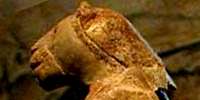 |
Loewenmensch, Löwenmensch, formerly often called Lowenfrau, the Lion Lady Venus - carved from mammoth ivory, it is 30 cm high and 6 cm in diameter. It was found in the cave of Hohlenstein-Stadel in the Valley of Lone, Baden-Wurttemberg (Germany), in 1931, dated as Aurignacian, in a level recently dated to 40 000 BP, making it the oldest sculpture known. Although this is known in some places as the lion lady, it is now known to be male. The arms bear striations carved into the ivory. Years after the initial discovery the museum officials were presented with an ivory lion muzzle found in the cave. It was a perfect fit. Today it is pieced together from more than 1000 tiny pieces. This male 'venus' may be an attempt to capture the power of the lion.
|
Ulmer Museum, Germany
|
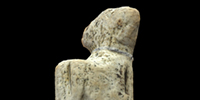 |
Der Kleiner Löwenmensch, the small lion man, was discovered during an excavation in 2001 in the Hohle Fels cave near Schelklingen - a figure that exhibits both human and animal characteristics. Unfortunately, only half of it is preserved. The upright posture and the distinctly sloping shoulders suggest a human being. Due to the condition of its preservation it cannot be ascertained with confidence whether this is meant to be a female or a male, but from the shape of the shoulders and pelvis, it was probably meant to be male.
|
Ulmer Museum, Germany
|
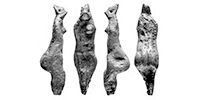 |
The Venus of Macomer is a possibly late Palaeolithic venus. In 1949, Francesco Marras, a carpenter of Macomer, in western Sardinia, started digging out with a friend the deposit of a small cave in his orchard, discovering prehistoric implements. He eventually assembled a large archaeological collection, without any recorded stratigraphic provenence, from the cave itself and from the area at the entrance. Most of it comprised lithic implements and potsherds, but a female figurine was also unearthed, now known as the Venus of Macomer.
|
Museo Archeologico Nazionale in Cagliari
|
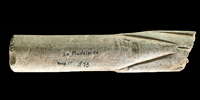 |
A new venus figurine has been recognised from La Madeleine, a rock shelter located in the Vézère valley, in the Dordogne, France. It was discovered by Capitan and Peyrony at La Madeleine, and was described in 1928 as a dagger blade made of reindeer antler. I thought it was a venus figure when I saw it on display in Le Musée National de Préhistoire, Les Eyzies-de-Tayac in 2008, and it has now been described as such by Jean-Pierre Duhard in Paleo 21, 2009-2010. |
Le Musée National de Préhistoire, Les Eyzies-de-Tayac
|
 |
There are two reclining bas relief venus figures at La Magdeleine des Ablis, which is located near Penne, in Tarn. The engravings and sculptures were found in 1950 by M. Bessac. Dating has been proposed for the engravings as being circa 13 000 BP, but this may be too young a date. Moreover, the works are not homogenous, and a considerable period of time may have elapsed between the engravings.
|
Grotte de la Magdeleine à Penne
|
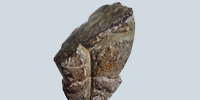 |
The Linsenberg - Mainz venus figures were found at the archaeological site which occupies a height overlooking the city of Mainz. It is an open air site, and is buried in loess, the archaeological layer lying just above a bed of clay. Around 1920 E. Neeb and O. Schmidtgen collected two fragments of venus figures made of greenish sandstone, which are kept at the Archaeological Museum in Mainz. The first, with a height of 36 mm, includes only the lower limbs, with feet represented by a blunt point, and part of the pelvis, with the pubic triangle. |
(?)
|
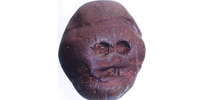 |
The Makapansgat pebble, or the pebble of many faces, is a 260-gram jasperite cobble with natural chipping and wear patterns that make it look like a crude rendition of a human face. The pebble is interesting in that it was found some distance from any possible natural source, in the context of Australopithecus africanus remains in South Africa. Though it is definitely not a manufactured object, it has been suggested that some australopithecine, or possibly another hominid, might have recognised it as a symbolic face, in possibly the earliest example of symbolic thinking or aesthetic sense in the human heritage, and brought the pebble back to camp, which would make it a candidate for the oldest known manuport at between 2.5 and 2.9 million years ago. |
(?)
|
 |
The Mal'ta - Buret' venuses and culture in Siberia - the site of Mal'ta, is composed of a series of subterranean houses made of large animal bones and reindeer antler which had likely been covered with animal skins and sod to protect inhabitants from the severe, prevailing northerly winds. Among the artistic accomplishments evident at Mal'ta are the remains of expertly carved bone, ivory, and antler objects. Figurines of birds and human females are the most commonly found items. |
Hermitage Museum, Saint Petersburg, Russia.
|
 |
The Venus called La Manche de poignard, or dagger handle, 27 000 BP, is from the Grottes du Pape, Brassempouy . The breasts are cylindrical and pendant, the belly is large and hanging. The depression of the spine in the middle of the back is well shown. Huge protuberances of fat cover the hips and descend a little lower than the place where the buttocks should arise. |
MAN47260, La salle Piette, Musée d'Archéologie Nationale et Domaine, St-Germain-en-Laye
|
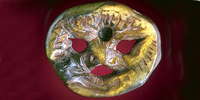 |
The Mask, or the Face, is a perforated oval disk in the form of a flattened face or mask, and is one of the Balzi Rossi venus figures. It is made of partially translucent green-yellow to yellow chlorite. Perforations create the eyes and a mouth. The eyes are circular, and small notches give them an animal rather than a human appearance. A series of incised lines radiates from the centre of the face across each cheek. The eyes, nose, and mouth have a vaguely feline appearance, but it may be either a stylised human or an animal. It may be more recent than the statuettes and have come from the rich Early Epigravettian deposits excavated by Jullien in the upper levels of the Barma Grande. |
Private hands. The Bust, Nun, Armless Lady, Ochre Lady, Two-Headed Lady, Couple, and the Mask were displayed in an exhibition at the Canadian Museum of History, Gatineau, Canada, in 1995.
|
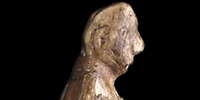 |
Sculpture of a female figure from Mas d'Azil, from the middle Magdalenian, discovered by Piette. This human bust, carved in the root of an incisor of a horse, shows a great mastery of sculptural technique. The nature, form and volume of material forced the sculptor to enclose the body within narrow limits. The originality of this sculpture is reinforced by the representation of the breasts, elongated and pendant, but not bulky. This secondary sexual characteristic allows us to identify it as a woman. There is also a second stylised venus figure, which is very reminiscent of the female/bird sculptures of Mizyn.
|
MAN47038, Musée d'Archéologie Nationale et Domaine, St-Germain-en-Laye
|
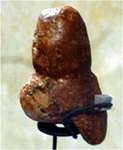 |
Mauern Venus - Weinberg Cave Venus - Die Rote von Mauern from Weinberg cave, or Weinberghöhlen, is a venus statuette in limestone, 27 000 years old, covered with red ochre when found at the Weinberghöhlen caves near Mauern, Bavaria. Lothar Zotz, on 24th August 1948, found the 72 mm tall limestone venus figure on the outer slope between cavities two and three of the Weinberghöhlen. During 1937-38, 1947-49, 1967 and 1974 bone fragments and traces of mammoth, cave bear, woolly rhinoceros, reindeer and 20 other different animals were found at the caves, as well as high quality Blattspitzen or leaf points of Mousterian / Neanderthal origin.
|
Archäologische Staatssammlung, München.
|
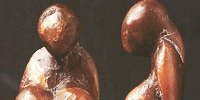 |
Venus of Menton, a figurine in yellow steatite (soapstone), Grimaldi. The figure is naked, breasts, abdomen and buttocks are prominent, the pubis and vulva are well marked. The arms are fused with the torso. The head is in the form of a ball, and extends down the back via the hair. It resembles many other venus figures from the upper European Palaeolithic. Found in 1880 in the Barma Grande and acquired by Salomon Reinach in 1896 for the French MAN.
|
MAN35308, Musée d'Archéologie Nationale et Domaine, St-Germain-en-Laye
|
 |
The 'venus' figurines from Mizyn have variously been described as phallic figurines, birds, and bird/woman hybrids. They were made in Mammoth ivory.
|
National Museum of History of Ukraine, Kyiv (?)
|
 |
The Venus of Milandes is a phallic shaped venus figure from the Dordogne valley, apparently of Paleolithic age. It was found by a five year old boy in a field, and taken home as one of a number of curiosities found that day. It was shaped from a silicified iron bearing limestone pebble, already with a phallic - feminine shape, and further altered to accentuate this interpretation. The object has a maximum height of 77.3 mm to a maximum width at the hips of 39.0 mm. The object weighs about 90 grams.
|
(?)
|
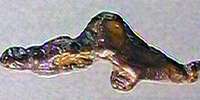 |
Monpazier Venus - The Venus of Monpazier was collected in 1970 on the surface of a freshly ploughed field by M. Elisée Cérou. It has a well drawn vulva. The pronounced buttocks and the projecting belly gave it the name Punchinello, but some see in it a woman about to give birth. Carved in limonite, a yellowish brown ore of iron. Often confused on the internet with the Polichinelle Venus.
|
MAN83303, Musée d'Archéologie Nationale et Domaine, St-Germain-en-Laye
|
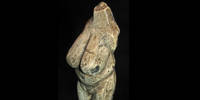 |
Moravany Venus - the Venus of Moravany is 76 mm tall, and was discovered when it was found in a ploughed field by a farmer in 1938 in the area of Moravany nad Váhom, a village near the spa resort Piestany in Slovakia. It is officially dated 22 800 BP and belongs to the shouldered points horizon (Willendorf-Kostenkian or Upper Gravettian).
|
The National Bank in the Slovak Republic
|
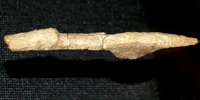 |
Nebra Venus - The site of Altenburg in the Stone Age was a particularly favorable place to settle. Excavations have uncovered a settlement of the Magdalenian hunters (about 17 000 BP). The tent-like dwelling was visited repeatedly over a number of summers. Floor plans and post holes of residential buildings have been identified. The most well known discovery is the 'Venus of Nebra', one of three sculptures in ivory approximately 7 cm high.
|
Vienna Natural History Museum
|
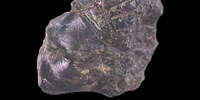 |
The Negroid Venus Head, in slightly fibrous green soapstone, has a surface which is polished and worn, especially the face. The base is polished and worn, which suggests that the object was already an isolated head in the Paleolithic. The piece measures 24 mm in height, 24.5 mm front to back and 15 mm maximum width, and is therefore relatively flat and has a protruding chignon of hair. The facial features are strikingly represented: there is a receding forehead with massive eyebrows and deep eye sockets. The cheekbones are strong. The coiffure, largely destroyed, is represented by a net or grid consisting of a series of incisions starting at the forehead, over the bun or chignon and back down onto the neck, cut by transverse incisions, the first of which form a kind of band above the forehead. |
MAN49284, Musée d'Archéologie Nationale et Domaine, St-Germain-en-Laye
|
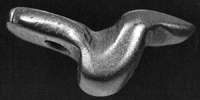 |
The Venus figures of Neuchâtel - Monruz - The Venus of Neuchâtel is a pendant in jet, and is 16 mm high. It was found at Neuchâtel in 1991, and is dated at 14 900 BP. The site of Monruz (commune of Neuchâtel) borders the lake over a length of a hundred metres. Formerly open to the air, it was by now covered with five metres of clay, sand, and gravel, capped by the bitumen of a trunk road. |
N° inv. NE-MZ 900004, Le Laténium, Parc et musée d'archéologie de Neuchâtel,Switzerland
|
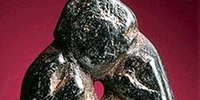 |
The Nun Venus, or the Flattened Figure is a Balzi Rossi or Grimaldi figurine which has been carved on a flat oval pebble of dark green chlorite and is about 44 mm high. The arms merge into the outer mass of the pebble, and the form brings to mind a female with a quasi-religious and hieratic bearing. The enveloping cape adds an air of mystery. |
Private hands. The Bust, Nun, Armless Lady, Ochre Lady, Two-Headed Lady, Couple, and the Mask were displayed in an exhibition at the Canadian Museum of History, Gatineau, Canada, in 1995.
|
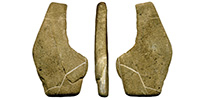 |
The Venus of Obłazowa, from the Nowy Targ district in Poland, is a Lalinde/Gönnersdorf figurine. These are strictly stylised and considered as evident female forms, with over-sized buttocks, long trunks, small or missing breasts, and no heads. This small stylised plaquette is 53 mm long, 32 mm wide and 7 mm thick. It was made of a flat pebble of flysch sandstone. |
(?)
|
 |
Ostrava-Petřkovice Venus. This miniature female torso, less than 5 cm in height, carved in haematite, comes from the Gravettian camp site of Ostrava-Petřkovice in Moravia, the Czech Republic. Age 27 000 years BP. It seems incredibly modern, almost cubist in style, and the pubic triangle looks like the bottom half of a modern bikini. The statue was discovered in 1953 by archaeologist Bohuslav Klíma, under a mammoth tooth in a pit cutting through the floor of an oval house, this female figure was deliberately carved to represent just the body without head or limbs.
|
Archaeological Institute of Brno, South Moravia |
 |
The Venus called la figurine à la pèlerine, or figurine dressed in a cape, from the Grottes du Pape, Brassempouy, consists of a fragment of the torso of a figure wearing a cape. The arm in bas relief is folded across the chest. Sculptors had recognised how fragile arms are when they are detached from the trunk, and they used bas relief to represent them. The arm tapers in thickness from the shoulder to the elbow. |
MAN47136, La salle Piette, Musée d'Archéologie Nationale et Domaine, St-Germain-en-Laye
|
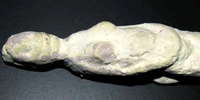 |
The Venus of Parabita is 90 mm high and 20 mm wide, and is made from a splinter of bone from an aurochs or horse. There are no features on the face, while the chin and neck is crossed by two parallel curved incisions, creating the impression of a collar or hood. From here the two sloping shoulders continue into arms, which become thinner, then thicker, and finally come together under a prominent abdomen, perhaps indicating pregnancy. A second venus is smaller, 61 mm high and 15 mm wide, and has different stylistic features. |
National Archaeological Museum of Taranto (?)
|
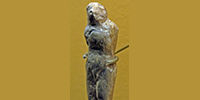 |
The Venus of Péchialet, from la grotte du Chien à Péchialet.
| MAN73759, Musée d'Archéologie Nationale et Domaine, St-Germain-en-Laye
|
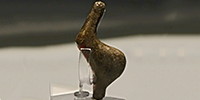 |
The Venus of Pekarna, from Pekarna Cave, Moravia. In the Lalinde or Gönnersdorf tradition, this mammoth is of ivory, height 45 mm, width 17 mm thickness 14 mm, and was discovered in 1927.
| Pavilon Anthropos: Moravské zemské muzeum, in Brno, Czech Republic
|
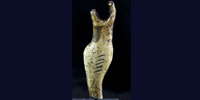 |
The Venus of El Pendo Cave, Camargo, province of Santander, may be of modern manufacture. It is in the form of a spear straightener or baton de commandement, made of deer antler, variously dated to the Solutrean or the upper Magdalenian, excavated by Abbé Jesus Carballo at El Pendo Cavern. Of interest is the form of the handle, which evokes the feminine form. This 'Venus' was discovered in the Solutrean layer of the El Pendo Cave. It is made of deer antler, and its form evokes that of a woman, with arms raised and with large hips.
| Musée de Préhistoire de Santander (?)
|
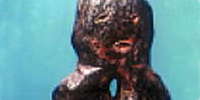 |
The Woman with the Perforated Neck, also known as the 'Janus' because the face is depicted on both sides of the flattened figurine, is one of the venuses from the Barma Grande in the Balzi Rossi caves. It is 62 mm long, of dark green steatite. The head is flat and circular, with the eyes and mouth carved on the front and back of the head. There are no forearms, and the breasts are oval-shaped. There is a prominent belly, and the buttocks are flattened. A small open vulva has been carved, and the knees and feet are indistinct or absent. It is perforated through the neck.
| Peabody Number: 2004.24.31759.2, Peabody Museum of Archaeology and Ethnology at Harvard University
|
 |
The Petersfels (Engen) venuses are made of jet, or hard coal, and were found at the Petersfels site, near Engen in Germany. It is one of the most important Palaeolithic sites in Central Europe with an enormous number of important artefacts. It was a settlement site of the Magdalenian (late Upper Paleolithic), with many layers, towards the end of the last ice age, during the period 15 500-14 000 BP. The main activity here was reindeer hunting in autumn.
| Archäologisches Museum Colombischlössle, Freiburg, Germany |
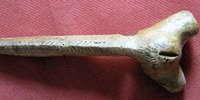 |
Placard Venus - La grotte du Placard is a decorated cave in the commune of Vilhonneur in Charante, 30 km east of Angoulême. It has been extensively researched and has levels dating from the Middle and Upper Paleolithic, especially the Magdalenian and Solutrean.
| (?) |
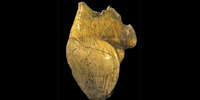 |
La Poire is a figurine of mammoth ivory of which only the corpulent torso survives, found in 1892 in the 'Grotte du Pape' at Brassempouy. The name 'Venus' for this figurine was subsequently adopted by Édouard Piette (1827-1906). She was originally nicknamed la poire - 'the pear' - on account of her shape. For Piette, the name 'Venus' may have come to mind in this particular instance because of the emphatic treatment of the vulva's labia and the prominent, slightly protruding pubic area, which he tastefully refers to as 'le mont de Vénus' - the mound of Venus (or mons pubis). 'Venus' has since become the collective term used to identify all obese Palaeolithic statuettes of women.
| MAN47333, La salle Piette, Musée d'Archeologie Nationale et Domaine, St-Germain-en-Laye |
 |
Polichinelle Venus - The Venus of Polichinelle, carved in green steatite, length 61 mm, 27 000 years old, found at Grimaldi. The pronounced buttocks and the projecting belly gave it the name Punchinello, but some see in it a woman about to give birth. Punchinello, or Polichinelle in French, is the short fat buffoon or clown in an Italian puppet show. Often confused on the internet with the Monpazier Venus.
| MAN49282, La salle Piette, Musée d'Archeologie Nationale et Domaine, St-Germain-en-Laye |
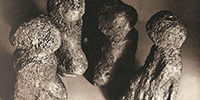 |
The Predmost venus figures are each carved from the toe of a mammoth. Seven figurines of this type were found at Predmost but only five survive. | Pavilon Anthropos: Moravské zemské muzeum, in Brno, Czech Republic |
 |
This is known as the Venus of Predmost, an engraving in a mammoth tusk of a stylised female figure. | Pavilon Anthropos: Moravské zemské muzeum, in Brno, Czech Republic |
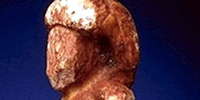 |
The Red Ochre Venus or Dame Ocrée is a female figurine made from mammoth ivory. The oval face has no facial features and the head and torso were originally covered with a very thick layer of red ochre. The hair forms a thick coiffure framing the face and tapering to two points that end on the backs of the shoulders, which may be interpreted as being braids. Although the upper arms are clearly carved at the sides of the figurine, there is no trace of forearms or hands.
| Private hands. The Bust, Nun, Armless Lady, Ochre Lady, Two-Headed Lady, Couple, and the Mask were displayed in an exhibition at the Canadian Museum of History, Gatineau, Canada, in 1995.
|
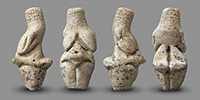 |
Another Palaeolithic Venus has been discovered in Renancourt, Amiens. The statuette is in good condition, carved in limestone/chalk, and is 40 mm high. It is estimated to be 23 000 years old, and is from the Gravettian. The breasts, buttocks and thighs are all of exaggerated volume, as is normal in this tradition.
| Musée de Picardie, Amiens |
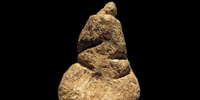 |
The Venus of Roc-aux-Sorciers was found in an Upper Paleolithic rock shelter site dating to the mid-Magdalenian cultural stage, ca 14 000 BP, made famous by its relief wall carvings. The south-facing rock-shelter is composed of two geologically distinct sections; below is the Abri Bourdois, a classic rock-shelter site beneath a slight overhang, and above is the Cave Taillebourg, a deeper vestibule. The art of Roc-aux-Sorciers is in two distinct categories - a 20 metre long frieze, still standing, not open to the public, and a series of sculptures, formerly on a wall of a collapsed section of the site. | MAN83797 (BDD 134), Musée d'Archéologie Nationale et Domaine, St-Germain-en-Laye |
 |
The Rogalik venus is a female figure engraved on a slate slab which has been used as a retoucher, from the late Palaeolithic, possibly around 13 000 BP.
| (?) |
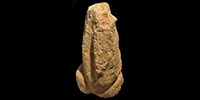 |
The second Venus of Roc-aux-Sorciers has many similarities to the first. It is apparently of the same lithic material, and stands 75 mm tall. | MAN83798, Musée d'Archéologie Nationale et Domaine, St-Germain-en-Laye |
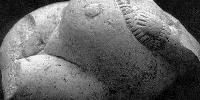 |
Venus figures from Russia, Ukraine and sites East of the Donau mouth. | Hermitage Museum, Saint Petersburg, Russia, and others
|
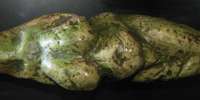 |
Savignano Venus - The Venus of Savignano is from the north Italian plain, and is 220 mm high. It is made of serpentine, and arms are indicated only, across the breasts. Found in 1925 at Savignano sul Punaro, near Modena. | CSE-S-002206-9511, Musée national de préhistoire et d'ethnographie Luigi Pigorini, Rome, Italy
|
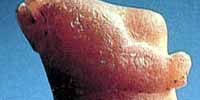 |
Sireuil Venus - The Venus de Sireuil was collected in 1900 in the Dordogne. It is made of translucent calcite. It was found in 1900 by M. Prat, on a road to a stone quarry, where a cartwheel which ran over it in the muddy rut where it lay unfortunately amputated the head and left hand which were not recovered. The material of the object is of amber calcite, slightly translucent, measuring 92 mm in height. Aurignacian flint was found 150 metres from the statue, in a quarry. It is estimated to be 27 000 years old. | MAN75664, Musée d'Archéologie Nationale et Domaine, St-Germain-en-Laye
|
 |
The Tan-Tan figurine was discovered during an archaeological survey by Lutz Fiedler, state archaeologist of Hessen, Germany, in a river terrace deposit on the north bank of the River Draa a few kilometers south of the Moroccan town of Tan-Tan. The lowest sediments contain red sands and pebbles and yields stone tools of typical Early Acheulian character. This layer is followed by an approximately 12 metre (40 feet) sequence of alluvial gravels, sands, and finer fractions of varying compositions, the lower part of which contains a rich industry of the Middle Acheulian, free of specimens of Levallois technique. | (?)
|
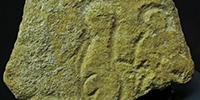 |
The engraving of the two venus figures at Terme-Pialat is so deep as to constitute bas-relief. It is believed to be from the Aurignacian. Terme-Pialat is near Combe-Capelle in the valley of the Couze, in the Dordogne region of France. | Musée d’art et d’archéologie du Périgord, Périgueux
|
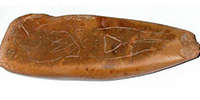 |
The Venus of Tolentino is a figure carved with a chisel on thin chert, height about 13 cm. The drawing depicts a woman with zoomorphic features. It has legs, breasts, and a geometric vulva, but the body is surmounted by a cow's head (or a herbivorous animal, bovid or equid). The Venus de Tolentino has been dated to a period between 5 000 and 12 000 years ago, between the Pleistocene and Neolithic, when agriculture developed in Europe. The stone on which the Venus is carved was probably used as a tool striker, or to crush seeds. Both ends are chipped from use. | Inventory Number 8803, Museo Archeologico Nazionale delle Marche, Ancona, Italy
|
 |
Le Torse - this Gravettian venus figurine was found during the 1896 excavations by Édouard Piette and J. de Laporterie at Grottes du Pape, Brassempouy. It was found in the upper part of the figurines layer, 4 or 5 cm above a fireplace. Dimensions: 94 mm high, 51.5 mm wide, 48 mm thick. | MAN47334, La salle Piette, Musée d'Archeologie Nationale et Domaine, St-Germain-en-Laye |
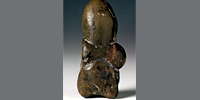 |
The Trasimeno Venus is a venus figure from the Paleolithic, found in Italy. It is about 37 mm high and carved in soapstone. It was found during excavations at Lago Trasimeno and is on display at the Museo Nazionale preistorico Etnografico Luigi Pigorini in Rome. | Museo Nazionale preistorico Etnografico Luigi Pigorini, Rome
|
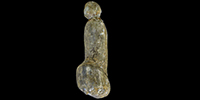 |
The Trou Magrite venus is a 38 mm high ivory statuette discovered by Dupont in 1867 during excavations conducted in the 19th century in the Trou Magrite near Dinant. It is the only venus from Belgium. It is believed to be from the Aurignacian.
| Probably at the Institut royal des Sciences naturelles de Belgique
|
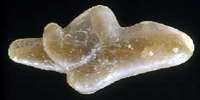 |
Tursac Venus - The Venus of Tursac is a calcite figure from 25 000 years BP. It was discovered on 5th August 1959 by M. Henri Delporte at Tursac, a village in the Perigord, near Sarlat, in the summer of 1959 at 'l'Abri du Facteur'. It is a treasure, a figurine made from a block of translucent calcite measuring 8 cm high and weighing 57.4 grams. While it lacks a head, arms and breasts it is still a very rare and important find.
| MAN81693, Musée d'Archeologie Nationale et Domaine, St-Germain-en-Laye
|
 |
The Woman with Two Heads, or Bicéphale, or Two-Headed Lady, is one of the Grimaldi Venuses, has a body made up of a narrow torso, no arms, projecting breasts and belly, and legs that taper to a point at the knees. The breasts are pointed, extremely large, projected forward, and extend laterally beyond the edge of the torso. Unlike the right breast, the left breast has two grooves circling it and a hole pecked in the tip, presumably representing a nipple. It has a flat back with a faint groove indicating the spine, a narrow waist, and wide hips. The centre of the abdomen is protruding and almost perfectly round and has a small navel in the centre. The large and circular buttocks are marked by a crease at the top and there is a pit carved at the approximate position of the anus. The very large pubic area contains a vulva that is indicated by a vertical groove.
| Private hands. The Bust, Nun, Armless Lady, Ochre Lady, Two-Headed Lady, Couple, and the Mask were displayed in an exhibition at the Canadian Museum of History, Gatineau, Canada, in 1995.
|
 |
The Undescribed Venus of Balzi Rossi is of opaque green soapstone. The oval head and the torso are of normal form and proportions, but the facial features are sketchy, with just sockets for eyes and the outline of a nose. The neck is well formed, the breasts, highly elongated from top to bottom, are separated from each other and the rest of the chest by very deep incisions. The material has changed in nature, and in part has converted to iron hydroxide, while maintaining the fibrous appearance of the original rock. The lower part is broken, we can not know if the statue was in a semi-sitting or standing position, or what was the form of the legs. The surface of the piece is less polished than others in the series, and is also much encrusted with iron concretions.
| MAN49280bis (sic), La salle Piette, Musée d'Archeologie Nationale et Domaine, St-Germain-en-Laye
|
 |
The Vogelherd Venus is one of the Lalinde - Gönnersdorf venus figurines, made of a boar's tusk, and was found at the 2008 re-excavation of the materials from the Riek excavation of 1931 in front of the Vogelherdhöhle cave. It is of Magdalenian age, from circa 13 000 BP.
| Urgeschichtliches Museum, Blaubeuren, Germany
|
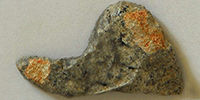 |
Female figurines in the style of Lalinde/Gönnersdorf from Wilczyce are unusual in that many are knapped from flint. Located on the Sandomierz plateau in southern Poland, the Wilczyce site was discovered in 1994 during a prospecting campaign carried out by the Polish Academy of Sciences. The site is located on a slope dominating the valley of the river Opatówka, and uniquely, the venus figures are all in 'ice wedges' deposits, which occur in areas subjected to permafrost.
| (?)
|
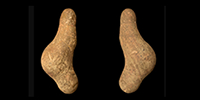 |
Waldstetten Venus - this venus, discovered in 2019 in the Ostalb District of Germany, outside the town of Waldstetten, was made in the Gönnersdorf style about 15 000 years BP. It is engraved with lines which further identify it as having the properties of a phallus.
| Tübingen University
|
 |
Willendorf Venus - The Venus of Willendorf, I, II and III. The Venus of Willendorf I is a superbly crafted sculpture of a naked obese woman from the stone age. It is made of oolitic limestone, and was covered with red ochre when found in 1908. The vulva is particularly well carved, by someone with a good knowledge of anatomy. The feet are rendered as very small, with no indication of ankles. Opinion is divided about the pattern around the head. Some say it is braided hair, others say it is a woven (or crocheted) hat pulled low over the face. There is evidence for woven textiles from that time. It could also be basketry. | Vienna Natural History Museum
|
 |
The Yeliseevichi venus, or Elisseevichi venus, is a finely modelled 15 cm tall figure depicting a shapely woman with no feet, head and hands, carved of mammoth tusk. The figurine has prominent buttocks and legs. The Yeliseevichi site was discovered in 1930 and it is located on the river Sudost, the right tributary of the Desna, in the Briansk Province, Russia. Most of the prehistoric artefacts were found in a heap of mammoth skulls piled next to a residential house.
| Hermitage Museum, Saint Petersburg, Russia.
|
 |
The Zaraysk Venus is not voluptuous, which puts it with the 'thin' Kostenki - Avdeevo venuses, but in this case there is one difference, that the legs are not placed together, which is also the case for the Willendorf venus. This testifies to the uniqueness of the Zaraysk site, which has features of both the Kostenki and Avdeevo cultures. Zaraysk or Zaraisk or Зарайск is an important Paleolithic site from the Ice Age in Russia, and is the northernmost example of the Kostenki - Avdeevo culture. | Zaraysk Kremlin Museum, near Moscow
|
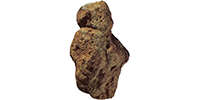
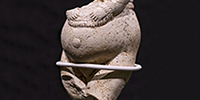 What was the purpose of the Palaeolithic Venus figures? This page gives an overview of the Venus Figures, and discusses the possible reasons for the creation of these iconic and mystifying figures.
What was the purpose of the Palaeolithic Venus figures? This page gives an overview of the Venus Figures, and discusses the possible reasons for the creation of these iconic and mystifying figures. 






























































































